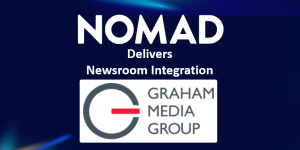
Nomad Media Showcases GenAI, Powerful Partners at NAB Show 2025
Nomad Media’s Collaborations Bring Innovative Content Management and Drive Business Results at NAB Show 2025
Providing better customer experiences for the AWS digital environment
Nomad’s key product offering, the Nomad Platform, is tailor-made to provide a better customer experience for users of Amazon Web Services (AWS). With the Nomad Platform, users and administrators can leverage the massive power and feature set of AWS through clean, convenient user interfaces.
AWS created the Advertising and Marketing Technology Competency to highlight companies that can deliver improved advertising experiences on the AWS platform.
Nomad has qualified for and was awarded the Advertising and Marketing Technology Competency in the Digital Customer Experience (DCX) category by AWS. This Competency certifies that Nomad meets Amazon’s high bar for product excellence in delivering cloud advertising technology to AWS customers.
Nomad’s flagship product, the Nomad Platform, is designed to provide a high-value customer experience. Here are some examples of our industry activities around helping customers understand the benefits of a better digital customer experience on AWS and employ the Nomad Platform to realize them for business value.

Nomad Media’s Collaborations Bring Innovative Content Management and Drive Business Results at NAB Show 2025

Nomad Media’s Collaborations Bring Innovative Content Management and Drive Business Results at NAB Show 2024

Success Story: Graham Media Group was able to consolidate all aired news stories within the cloud, easily accessed by all member stations.

Nomad and Rumo by Spideo Collaborate to Bring Innovative Content Management and Discovery to NAB Show 2023.

Learn how FanDuel is using Nomad to make, manage, and monetize their media and entertainment content.

Nomad, “Discover your Content’s Potential”, announced today that it has achieved the Amazon Digital Customer Experience Competency, part of the Amazon Web Services (AWS) Partner Competency Program.
We’ve selected two public case studies to describe how we deliver proven content management expertise to our customers so they can easily and securely manage, discover, enrich, and distribute their media content to a global audience.
Technology and entertainment company On Air developed a solution to bring high-quality live streaming concerts to viewers globally using AWS. After launching its initial streaming solution, On Air experienced rapid success and began looking for a more robust solution with the ability to broadcast in different formats. The company contacted AWS Partner Nomad, and together they developed a new, integrated streaming environment built entirely on AWS. Now, On Air has the ability to broadcast concerts in ultrahigh definition, supports multiple languages and currencies, and has achieved an over 60 percent time savings in its media workflows.
Experiencing Rapidly Growing Demand
On Air needed to meet a sudden increase in demand following the success of its first online streaming solution for live concerts and performances. During the COVID-19 pandemic, the demand for live streaming content increased rapidly, and the company’s solution couldn’t support this sudden growth. On Air reached out to AWS Partner Nomad for assistance developing a more robust solution.
Nomad provided On Air with a demonstration of the content management system (CMS) it had developed using Amazon Web Services (AWS). “Building this solution on our own would have been very time consuming,” says Angelo Lamme, head of product at On Air. “Nomad CMS is already a proven solution. It was very clear to us that Nomad understood our language so we could start customizing Nomad CMS to make it suitable for our needs.” Using an integrated solution that it developed alongside Nomad, On Air is now well positioned for future growth.
Customizing a Proven Solution to Facilitate Growth
Nomad offers solutions for video creation and live streaming. The company takes advantage of the AWS Software Partner Path and belongs to the AWS Solution Provider Program, which helps AWS Partners resell and deliver AWS services to customers as part of the AWS Partners’ unique offerings. The company has staff possessing five AWS Certifications, including AWS Certified Solutions Architect—Professional, a credential that helps organizations identify and develop talent with critical skills for implementing cloud initiatives.
Nomad uses AWS extensively in its solution. A core part of Nomad CMS is Amazon API Gateway, a fully managed service that makes it easy for developers to create, publish, maintain, monitor, and secure APIs at any scale. It is used for all external requests to Nomad components. For the web file host, Nomad CMS uses Amazon Simple Storage Service (Amazon S3), an object storage service offering high scalability, data availability, security, and performance. “On Air came to us and said that they needed to get this new solution online,” says Adam Miller, founder and lead architect of Nomad. “Using Nomad CMS made it simple for us to integrate most of the technology and bring it directly into their user interface.”
Creating a Video Streaming Solution in the Cloud
Nomad customized the solution it developed for On Air so that it could integrate seamlessly with On Air’s existing online streaming solution. Nomad’s solution became On Air’s new backend, making it possible for On Air to focus on the front end of its solution. Nomad also improved the content management features of the solution, simplifying several processes for On Air, including finding its content definitions, managing the metadata and relationships, and creating a scalable, high-performance interface. Next, Nomad brought On Air’s video streams online for increased ease of use in broadcasting the media. To transcode and package media into web-friendly formats for optimal playback, the solution uses Media Services on AWS, which lets users create digital content and build live and on-demand video workflows.
AWS Cloudfront was used as On Air’s Content Delivery Network due to its capabilities and native integration with S3 and Elemental MediaLive. AWS Cloudfront is a world-class scalable distribution system fully capable of service On Air’s live streaming and Video on Demand distribution needs. This capability is essential to On Air’s business model of serving the artistic performance industry as an online distribution platform.
Nomad’s installation automatically configured AWS CloudFront to serve On Air’s S3-hosted content through pre-signed URLs secured to FIPS 140-2 encryption standards. Nomad also configured masked origins via AWS Origin Access Identities and set up dedicated AWS CloudFront distributions with best-practice performance and security policies. In addition, Nomad configured policies to serve packaged distributions from AWS MediaStore containers through AWS CloudFront distributions to handle the large quantities of on-demand content processed through AWS MediaLive by On Air on behalf of its customers.
“What’s nice is that through the power of the cloud, we have the ability to distribute it instantly with high performance,” says Miller. “So when these big shows come online, we have the ability to scale it instantly from tens of thousands to hundreds of thousands, if not millions, of users, and you don’t have to touch your infrastructure. It just works.”
To manage user accounts, the solution employs Amazon DynamoDB—a fully managed, serverless, key-value NoSQL database designed to run high-performance applications at any scale—and Amazon Cognito, which businesses can use to add user sign-up, sign-in, and access controls to web and mobile apps quickly and easily. To use the service, fans sign into their On Air accounts and click an event link. The virtual venue solution delivers high-definition video and audio using AWS Elemental MediaLive, a broadcast-grade live video processing service. “Until now, we’ve only been able to broadcast our events in high definition with stereo,” says Lamme. “With the new solution that we’ve built based on Nomad CMS, we’re now able to fully broadcast in ultrahigh definition using immersive audio technology.” Additionally, working together with Nomad, On Air was able to customize the solution further to support multiple languages, currencies, and time zones.
Because its new solution was built on Nomad CMS, On Air is realizing a more than 60 percent time savings in regard to its media workflow. With its old system, a facility partner would upload assets to a file transfer protocol server. On Air would then need to download the asset, reformat it, postprocess it, and upload it to a legacy video provider. Now, On Air doesn’t need to worry about any of that. . “Everything is handled in a very elegant way by Nomad CMS,” Lamme says. And for long-term storage of the original media files after transcoding, On Air uses Amazon S3 Glacier, which lets users choose from three archive storage classes optimized for different access patterns and storage duration.
Realizing Success through Collaboration
Working alongside Nomad and building on AWS, On Air quickly implemented a solution to support a high-quality live streaming concert experience. The company appreciates the support it received from Nomad in creating this solution, as well as the knowledge about best practices and streamlining processes that Nomad brought to the collaboration. “We really wanted a partnership,” Miller says. “We wanted to be able to take our expertise that we’ve gathered over the years and work with On Air.”
By working with Nomad and its streaming solution, On Air achieved a customized solution much more quickly and cost effectively than it could have done alone or by working with multiple vendors. “We were able to customize Nomad CMS into what we wanted it to be,” says Lamme. “This technology made innovation possible in a big way for us.”
At the start of the COVID-19 pandemic, educators around the world found themselves lacking the resources to move their courses to an online format. This was particularly true for educators teaching gross anatomy to undergraduate, graduate and professional students. The need for high quality cadaveric dissection videos and images became urgent . The VDD needed an easy-to-use system for educators to find and access materials and media for their presentations and exhibit them live from any global classroom.
The VDD needed the system to serve several common content management functions:
• Centralize the storage of large volumes of materials and media
• Provide file / folder and taxonomical asset management
• Enable effective search of the media and associated metadata
• Support online registration of lecturers and record acceptance of Terms of Use
In addition, the VDD needed the system to provide an easy-to-use public-facing interface for lecturers to exhibit media during lectures.
In September 2020, creators of the VDD chose the combination of the Nomad Platform and AWS to serve their needs because the Nomad / AWS pairing offered a full range of content management capabilities, including media management and distribution, and a public- facing Content Portal.
The creators of the VDD needed to maintain the highest ethical standards due to the content available in the VDD library. Their goals included:
1) Securing cadaveric educational material use to registered and approved users only.
2) Ability to approve all content by an internal review board prior to publication.
3) Signed acknowledgement of media asset ownership from content donors to prevent unauthorized distribution.
4) Singed acknowledgement of content donors’ acceptance of the VDD creative commons licensure.
Integration of the Nomad / AWS Solution
Nomad assisted the VDD with setting up an AWS account and deployed baseline Nomad and Discovery Content Portal installations into the account. Nomad customized the look, feel and front-end functionality of the Nomad Platform and Content Portal
installations to the VDD’s requirements, then assisted content donors with the transfer of media assets into the S3 storage of their AWS account. Nomad also assisted content donors with importing metadata attached to media assets and synchronizing the data with the assets. Nomad trained the VDD administrators on the use of the Nomad Platform and supported their early efforts to organize their assets to their needs.
Drawing on the capabilities of the AWS feature set, Nomad’s Asset Manager and associated user security management allowed VDD administrators to centrally manage all website content assets with clear user permissions and file / folder organization.
Educators have the ability to exhibit media directly from the VDD website for their lectures.
Educators can now register accounts and fill out web forms confirming acceptance of Terms of Use for the media, and this information is automatically collected and forwarded to the administrators. This streamlined the user registration process to access the VDD’s assets.
For the VDD, the Nomad Platform and AWS delivered a highly useful back-end feature set, including:
• Asset intake, processing, and management for S3-hosted assets
• Search / Advanced Search of hosted assets
• AI / ML analysis of and metadata generation for media assets
• Media properties and preview
• User and asset security management
• Video-on-Demand media processing, and distribution management
Nomad’s leveraging of AWS Media services optimized the media for both cost-effective playback and long-term storage by creating web-friendly proxies of the uploaded media on-the-fly and transitioning the originals to long-term storage automatically afterwards. This ensured that at the time of launch of the site, the web-friendly media assets were compatible with a wide array of devices and ready for online use and the original assets were secured in deep storage.
The Nomad Platform also provides a full-featured set of user interfaces for user, content, and security management by administrators, and the Discovery Content Portal provides user registration services and media search and playback for authorized lecturers.
The following services were key to Nomad’s fulfillment of the VDD’s needs:
• The Amazon API Gateway is a core part of the Nomad architecture and was used for all external requests to Nomad components.
• S3 was integrated as the web file host for its ability to host web files.
• Amazon Route53 was chosen to provide DNS services for the site.
• Amazon CloudFront was implemented to offload site traffic from the origin AWS account.
• Amazon Cognito and Amazon DynamoDB are engaged to manage Nomad application user accounts.
• Amazon Media Services are used to transcode and package media into web- friendly formats for optimal playback.
• S3 Glacier is employed for long-term storage of the original media files after transcoding.
The project was successful in addressing the VDD’s requirements and realized additional benefits as well. Through their collaboration with Nomad, the VDD was successfully able to establish cloud media storage with centralized management and decentralized access to media for educators. The media assets were successfully imported, proxied for web use, and archived in long-term storage. The assets inherited the correct metadata and were organized through taxonomies in a group effort. New versions were identified and selected for distribution and past versions were deprecated.
Educators are able to easily integrate media exhibition during lectures. The associated business process of granting access to educators and permission to use media was also streamlined by Nomad’s user registration and Terms of Service acceptance forms.